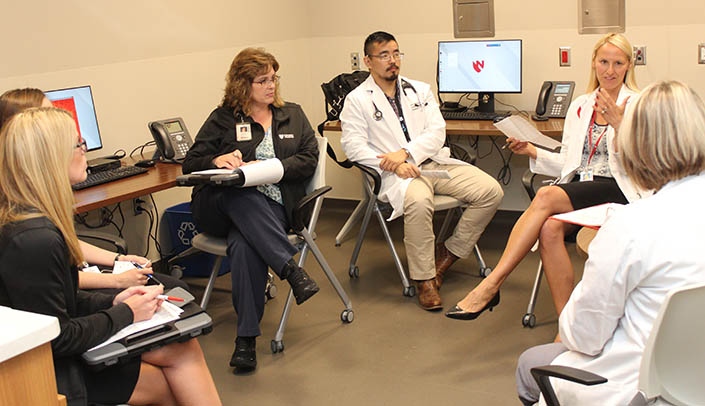On July 1, Nebraska Medicine’s Internal Medicine Hospital Medicine service team, often referred to as hospitalists, adopted a new rounding model at the medical center, designed to improve efficiency, collaboration and patient care.
A hospitalist is a physician who works exclusively in the hospital and provides care to patients while they’re hospitalized, said Rachel Thompson, M.D., UNMC section chief of hospital medicine, medical director, Clinical Care Transitions, and professor of internal medicine-general medicine at UNMC.
“On an average day, our team is caring for 100 to 130 patients,” Dr. Thompson said.
These are patients defined as “hospital medicine,” meaning they are hospitalized for a medical reason and primarily do not include surgery patients, except for those whose health condition require a medicine specialist around the time of surgical intervention.
“We realized on any given day, we may be in 10 different units in four different bed towers,” Dr. Thompson said, adding that high patient volumes and patient acuity contributed to increasing complexity of care.
With the known benefits of geographically co-locating physicians on specific nursing units, the work to develop a new model at Nebraska Medical Center has been on the radar in recent years. The opening of the Fred & Pamela Buffett Cancer Center added the fuel needed to push the change through.
“We asked ourselves ‘how can we make this less chaotic?'” Dr. Thompson said. “If we can’t assign individual floors, what about towers?”
The new rounding model eliminates references to the Internal Medicine/Hospital Medicine service teams as “Grissom” and “Loomis” and creates three new rounding teams: IM/HM Lied, IM HM Clarkson and IM HM Werner.
“This is a geographic style of rounding that allows for a provider to be integrated into the unit,” Dr. Thompson said. “This allows them to spend more time with patients and families, nursing staff, and allows for more conversation with consultants. Face-to-face communication is always better than phone calls and text messages.”
Along with the new teams, a new multidisciplinary rounding approach also has launched.
“As part of our work to integrate, we want to improve our multi-disciplinary approach to patient care,” Dr. Thompson said.
Participating twice a day are social workers, a care transition nurse, lead nurses, pharmacy and PT/OT.
“The rounds will focus on the progress of the patient, their needs, their support system and how we can help them be successful after they’re discharged,” Dr. Thompson said.
The rounds will take a standardized approach so everyone knows their role. The team developed a checklist to help facilitate the discussion.
“Our hope is the integration improves the care we provide, reduces the number of safety events and the length of stay and results in higher patient and nursing satisfaction,” Dr. Thompson said.
Learn more about the structure of the teams and the process for admissions and consult requests.
